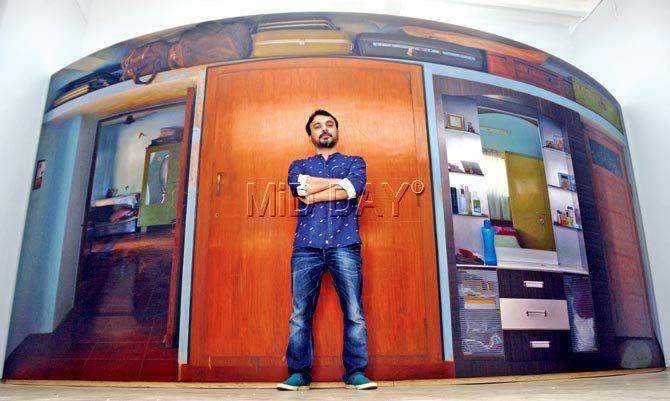A Kutchi house that travelled to Kochi now comes to Mumbai in Abir Karmakar's solo exhibition, Displacement

Artist Abir Karmakar with Wall 7, which was previously shown at Kochi Muziris Biennale. In this exhibition, the work has taken on parabolic dimensions. Pic/Snehau00c3u00a2u00c2u0080u00c2u0088Kharabe
When artist Abir Karmakar tells you that his paintings are less about architecture and more about people, it may sound puzzling at first. After all, in his latest solo exhibition, titled Displacement, Karmakar's colossal paintings have the ability to teleport viewers into a home through painstaking renditions of paraphernalia and interior décor. Calendars with prints of divinities, suitcases crammed into lofts, kitschy sculptures of nymphs, and display cabinets with random thingamajigs abound in Displacement.

Artist Abir Karmakar with Wall 7, which was previously shown at Kochi Muziris Biennale. In this exhibition, the work has taken on parabolic dimensions. Pic/Snehaâu00c2u0080u00c2u0088Kharabe
ADVERTISEMENT
While the residents of this home, evidently furnished according to middle-class taste, are never to be seen, the paintings do not seem de-peopled. In fact, there is a sense of intimacy that Karmakar creates through the eight paintings that will be on view at Colaba's Galerie Mirchandani + Steinruecke Tuesday evening onwards. "You enter someone's private space and you know who they are through the marks they have left. You catch a glimpse of their fingerprints on a wall, for instance, and wonder who they are," says the artist.
As art historian Birgid Uccia, curator of this show, writes in her curatorial note on Displacement, "Karmakar's interiors are devoid of human presence. In muted colours, he celebrates the palpable tension between the glaring absence of the figure and its presence made visible through the objects of everyday life. Suitcases, kitchen utensils, clothes, trinkets, and furniture imprint the empty space with their marks. They are not inanimate objects, but encode a layered past, memories..."
It's as if you have known the people who live here. But, where are they? In Displacement, Karmakar works with presences and absences. Perhaps the lady of the house is just down the stairs that we see in one of his paintings. Perhaps the children are hiding under a bed in a game of hide-and-seek. Their father might be in the kitchen, blocked from our view.
For Karmakar, the theme of displacement is one that he is all too familiar with. Born in 1977 in Siliguri, Bengal, and educated in Kolkata and later Baroda, where he is now based out of, Karmakar has been shaped by the experiences in these different places. "Having lived away from Siliguri, when I go back to the city, I feel I don't quite belong there, even though I love it. However, I try not to impose my personal background in my works," says Karmakar, who won the first Asia Arts Future Award, instituted by Asia Society, earlier this year.
"I refer to displacement in the more formal aspects as well," he continues. The house that Karmakar opens up to us in Displacement is one that he visited while on a family trip to Kutch. It's a stranger's house that we encounter in the paintings, five of which were first shown as Home at the Kochi Muziris Biennale's third edition in 2016. "I wanted to see what it would mean to transport a house from Kutch to Kochi," says Karmakar.
The visual transfer of the Kutchi house to Kochi meant that the works would have to be large-scale, to meet the ends of the walls. "In Kochi, Home was shown in at Kashi Art Gallery [an old Dutch house] as a site-specific work. With Displacement, I explore how the same paintings interact differently in this gallery," he explains. While the scale and detailing of the paintings may tempt us to use the word "photorealism", it is one that Karmakar resolutely abstains from using. The house, as he saw, is manipulated, on canvas, for better composition and to challenge the viewer's perspective. The layout is such that you get a sense of walking through the house, only to have your illusion shattered from time to time as you see the frames and the white walls.
If you are like us, then you might feel a sense of discomfort. You could be invading a stranger's house; or, it could be that it feels like your house has been laid bare in front of strangers to see. "But, for me, this is what I remember my past as. It is comforting and relatable," differs Karmakar.
Where: Galerie Mirchandani + Steinruecke, Sunny House, behind Taj Mahal Hotel, Colaba
When: November 14, 2017 - January 11, 2018
Call: 22023030
 Subscribe today by clicking the link and stay updated with the latest news!" Click here!
Subscribe today by clicking the link and stay updated with the latest news!" Click here!







